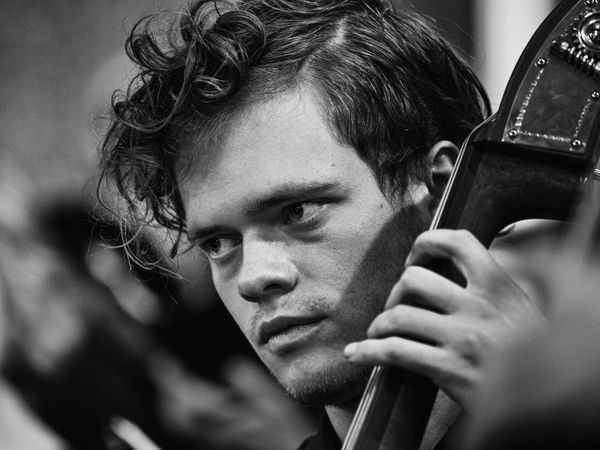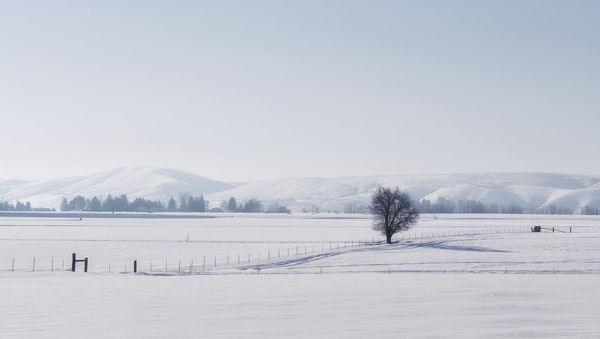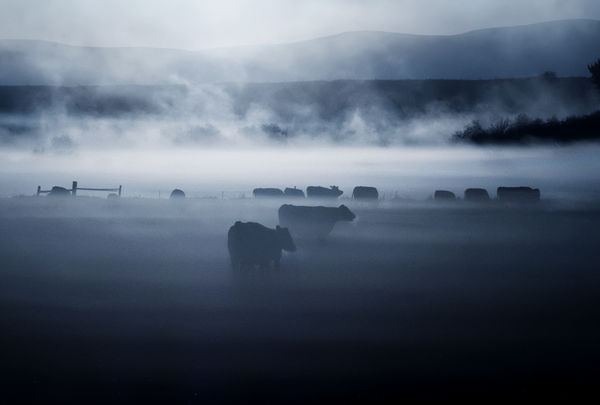When not to sharpen - share your stories and pics
Jul 9, 2019 15:37:14 #
I decided to move a side conversation from John Howard's topic to a new topic so that we're not hijacking. In response to my saying I "never" sharpen I was asked, "Is that because of the type of images you create, or is there another reason? I ask because I've seen comments from the other extreme - those who worship sharpness - but never from a total non-sharpener...."
My reply + a couple of examples where I feel that global sharpening would be detrimental to (opposite of) the mood I wanted to capture:
It's mostly because of the look I enjoy (via pp) and what attracts me out in the field: soft light and/or fog, for example.
On the occasion I want some semblance of sharp, I go to Topaz Detail or Nik detail extractor, or use other tools such as tonal contrast. I have also done (rarely) selective sharpening of a small part of an image. And I'll up the clarity while still in ACR with the raw file.
Part of this is simply habit, based on what I did when first learning the software and liking it enough to not bother to try anything different; and part is being put off by seeing over-sharpened images on UHH ("over-sharpened" is simply an opinion, of course ).
).
Please feel free to post a photo and continue the discussion.
My reply + a couple of examples where I feel that global sharpening would be detrimental to (opposite of) the mood I wanted to capture:
It's mostly because of the look I enjoy (via pp) and what attracts me out in the field: soft light and/or fog, for example.
On the occasion I want some semblance of sharp, I go to Topaz Detail or Nik detail extractor, or use other tools such as tonal contrast. I have also done (rarely) selective sharpening of a small part of an image. And I'll up the clarity while still in ACR with the raw file.
Part of this is simply habit, based on what I did when first learning the software and liking it enough to not bother to try anything different; and part is being put off by seeing over-sharpened images on UHH ("over-sharpened" is simply an opinion, of course
 ).
).Please feel free to post a photo and continue the discussion.
Jul 9, 2019 15:59:36 #
Keep in mind the default sharpening setting for ACR is +25 for all RAW files types (with no regard to the camera, lens, etc). This default value is evident in the EXIF of the first image of this post.
For my own work, I prefer a higher value as well as refinements to the Radius, Detail and Masking values where the same sliders exists in LR as in ARC. Using the <ALT> key against the slider gives a better understanding of the purpose and impact of each of these sliders.
Although this post appears to be specific to CS4, it actually applies to two other Adobe products (LR, ARC) for explaining the sharpening sliders: https://www.photo.net/learn/camera-raw-sharpening. I've found a masking value in the 55 to 95 range (depending on image content) has the most impact (refinement) on the quality of the results.
For my own work, I prefer a higher value as well as refinements to the Radius, Detail and Masking values where the same sliders exists in LR as in ARC. Using the <ALT> key against the slider gives a better understanding of the purpose and impact of each of these sliders.
Although this post appears to be specific to CS4, it actually applies to two other Adobe products (LR, ARC) for explaining the sharpening sliders: https://www.photo.net/learn/camera-raw-sharpening. I've found a masking value in the 55 to 95 range (depending on image content) has the most impact (refinement) on the quality of the results.
Jul 9, 2019 16:06:39 #
CHG_CANON wrote:
Thank you, Paul! I forgot all about that, so I guess I'm often working against something I could have avoided to begin with Keep in mind the default sharpening setting for ACR is +25 for all RAW files times (with no regard to the camera, lens, etc). This default value is evident in the EXIF of the first image of this post...

Appreciate your additional information and your time. Great stuff!
Jul 9, 2019 16:32:38 #
It seems to me that if softness is what you want for most of your pics, that puts you in a minority. Most of us have room for some soft images in our collections but prefer the extra vividness of sharpness for most of our output. I suspect that when you refer to a semblance of sharpness you're referring to vividness - which can be achieved using contrast, clarity and saturation as well as sharpness. But at those times when vividness is the goal, adding sharpness will be seen as a necessary step without which the result will be less than optimal.
It seems to me that definition of shape is a good thing most of the time, including many of the times when softness is the objective. That is why edge-based sharpness should be thought of as separate from the sort of global sharpness that amplifies textures as well as edges. I suspect that when you refer to over-sharpening you're referring to the unpleasant effect that sharpening can have on textures, leaving things looking "gritty". In the past I've used large amounts of edge-based sharpening which leaves the textures alone for the most part, and in those cases I've never had anybody comment on the amount of sharpening that I've used. In other words if you can avoid amplifying the textures you can use generous amounts of sharpening without it producing undesirable side effects. That is why I try to think of textures separately and try to treat them separately. If there are areas in a shot that have textures that need boosting it can be done with a brush.
When not to sharpen? When there's noise or textures that you don't want amplified. Beyond that I'm willing to use liberal amounts of edge-based sharpening that can do much to differentiate shapes - which as a general rule is an enhancement which adds visual impact and interest. As a general rule our eyes appreciate any help they get with the task of discerning shape and detail. What our eyes very often don't like is the jarring effect of viewing over-harsh textures.
It seems to me that definition of shape is a good thing most of the time, including many of the times when softness is the objective. That is why edge-based sharpness should be thought of as separate from the sort of global sharpness that amplifies textures as well as edges. I suspect that when you refer to over-sharpening you're referring to the unpleasant effect that sharpening can have on textures, leaving things looking "gritty". In the past I've used large amounts of edge-based sharpening which leaves the textures alone for the most part, and in those cases I've never had anybody comment on the amount of sharpening that I've used. In other words if you can avoid amplifying the textures you can use generous amounts of sharpening without it producing undesirable side effects. That is why I try to think of textures separately and try to treat them separately. If there are areas in a shot that have textures that need boosting it can be done with a brush.
When not to sharpen? When there's noise or textures that you don't want amplified. Beyond that I'm willing to use liberal amounts of edge-based sharpening that can do much to differentiate shapes - which as a general rule is an enhancement which adds visual impact and interest. As a general rule our eyes appreciate any help they get with the task of discerning shape and detail. What our eyes very often don't like is the jarring effect of viewing over-harsh textures.
Jul 9, 2019 16:39:07 #
CHG_CANON wrote:
Keep in mind the default sharpening setting for AC... (show quote)
That is a nice article, and still applies to cc very nicely.
Jul 9, 2019 16:40:07 #
R.G. wrote:
I've seen the effect described as "crunchy" ... I suspect that when you refer to over-sharpening you're referring to the unpleasant effect that sharpening can have on textures, leaving things looking "gritty"...
 Also, with whatever was done to make the photo unpleasing (to me), the global application caused the background to compete with the subject; I'm thinking more of flowers and other close-ups here, not landscapes so much.
Also, with whatever was done to make the photo unpleasing (to me), the global application caused the background to compete with the subject; I'm thinking more of flowers and other close-ups here, not landscapes so much.Your comments are very interesting, well explained and definitely worth studying and trying out. Thanks so much, R.G.!
Jul 9, 2019 16:44:54 #
MichaelH
Loc: NorCal via Lansing, MI
CHG_CANON wrote:
Keep in mind the default sharpening setting for AC... (show quote)
I believe the default sharpening in the current Lightroom is now +40.
Jul 9, 2019 16:49:17 #
I think also if you take the extra time to make a careful selection you can sharpen that then invert it to 'soften' the background, maybe with a bit of feathering on the selection, so less sharpening can still make the subject stand out relatively.
Jul 9, 2019 16:51:08 #
bleirer wrote:
I'm not sure if you're speaking to me or another respondent, but I appreciate your suggestion and your interest in the thread.I think also if you take the extra time to make a careful selection you can sharpen that then invert it to 'soften' the background, maybe with a bit of feathering on the selection, so less sharpening can still make the subject stand out relatively.
In PS Elements I would probably create a new (blank) layer, then use the sharpen tool selectively. Or maybe with selection tool and inverting the selection as you suggested, create a new layer of that selection (copy/paste), then use a very light touch of Gaussian blur? As always, lots of ways to reach the same goal. Will we ever know it all?

Jul 9, 2019 18:15:18 #
Linda From Maine wrote:
I decided to move a side conversation from John Ho... (show quote)
For me since my camera uses an ante moire filter which adds a touch of softening I like to remove that touch although one of the first steps in post is to zero out the default sharpness settings in ACR. Later in the process, often as a final step, sharpening is worked on. If I want a soft image (seldom) there are always PS filters, primarily "Gaussian blur"
Jul 9, 2019 18:37:40 #
Rich1939 wrote:
Interesting to know your process, Rich. Many thanks!For me since my camera uses an ante moire filter which adds a touch of softening I like to remove that touch although one of the first steps in post is to zero out the default sharpness settings in ACR. Later in the process, often as a final step, sharpening is worked on. If I want a soft image (seldom) there are always PS filters, primarily "Gaussian blur"
Jul 9, 2019 20:58:04 #
For myself it is almost always, except for when I specifically want a "soft" look.
Sometimes it is very much subject dependant, for example when shooting older lady choir members as in the example #1. My wife (pictured) always check the images before I upload them to make sure the ladies look "good". Sometimes I will soften the skin a little.
For the men sometimes I want a gritty look as in example #2 (shot at very high ISO) and example #3.
When post processing the first thing I do is to remove any changes that are made by the PPing software, including sharpening of the raw files.
Sharpening is the last thing I do and it is alway done on another layer, with the blend mode set to luminosty (to reduce noise) and the opacity of that layer adjusted to "fine tune" the adjustment.
.
Sometimes it is very much subject dependant, for example when shooting older lady choir members as in the example #1. My wife (pictured) always check the images before I upload them to make sure the ladies look "good". Sometimes I will soften the skin a little.
For the men sometimes I want a gritty look as in example #2 (shot at very high ISO) and example #3.
When post processing the first thing I do is to remove any changes that are made by the PPing software, including sharpening of the raw files.
Sharpening is the last thing I do and it is alway done on another layer, with the blend mode set to luminosty (to reduce noise) and the opacity of that layer adjusted to "fine tune" the adjustment.
.
#1 The lady in the midle checks my images before they are uploaded.

(Download)
#2 Gritty look and very high ISO

(Download)
#3

(Download)
Jul 10, 2019 00:26:04 #
When I see "Sharpness", I think "Focus". I understand there will be times when "Softness" or "Blur" is called and when a photo is really "Sharp", doesn't that mean "In Focus" ? I ask this because if some of the comments posted substituted the word focus for the word sharpness, the sentence would not make sense. Personally, I want all of my photos to be sharp. In the previous sentence, if I substituted the words "In focus" for "Sharp", I don't think I would change the meaning. If I want to add a mood, I think it would be easier to do in PP. Did I miss something about this discussion?
Jul 10, 2019 06:28:24 #
Linda From Maine wrote:
I decided to move a side conversation from John Ho... (show quote)
Sharpening would not improve these four wonderful landscapes. You cannot improve the perfect.

Jul 10, 2019 07:10:00 #
RichardTaylor wrote:
Great examples and information, Richard. Thanks so much!For myself it is almost always, except for when I... (show quote)
If you want to reply, then register here. Registration is free and your account is created instantly, so you can post right away.










